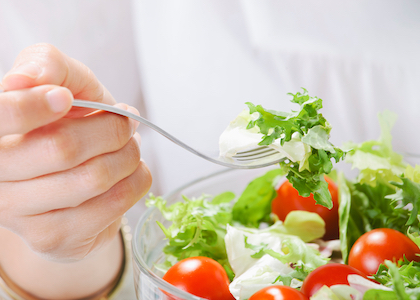
6 Ways to Make an Awesome Salad for Work
By Kristen DeAngelis
Eating a colorful salad once a day is an excellent way to fuel up at work—with the right ingredients, lunch can help keep blood sugars stable and provide you a consistent source of thriving energy for high functioning productivity.
The key to having lasting energy is to fill up on meal that’s rich in fiber, complex carbohydrates and lean proteins. You can either pack your salad in a plastic container or in a mason jar and store in your office break room. Follow these simple salad making rules and ingredients to add in for an awesome salad at work.
1. Start with lots of greens and mix it up.
Everything from spinach, kale, romaine, micro greens and mixed lettuce has a variety of unique phytonutrients for cellular health. Choose what’s local and in season to get the most nutrition. With tons of greens as your base, you’ll add a lot of volume and nutrition with very few calories. A higher intake of these non-starchy leafy greens is associated with decreased body weight — that’s a big plus if you’re aiming to maintain weight with the limitations of a sedentary desk job!
2. Add colorful raw or roasted veggies.
After building a green base, add in your vegetables, which have powerful effects on reducing risk of cancer, reducing inflammation and supporting weight loss and weight management. Opt for locally sourced, seasonal veggies whenever possible to get the most nutrients, antioxidants, vitamins and minerals.
- Keep it raw: Try sliced cucumber, bell peppers, shredded carrots, radish, cherry tomatoes, sprouts or mushrooms.
- Or opt for roasted: Add roasted sweet potato or butternut squash cubes with olive oil and cinnamon, or make a savory mix of zucchini, summer squash, cherry tomatoes and green beans with garlic and olive oil for lots of interesting textures and flavors. I love roasting a ton of vegetables on Sunday and packing them up to have cold on my salad throughout the workweek.
3. Layer in a protein.
Having a protein paired with fiber-rich veggies is one of the most important pieces of a truly awesome salad. Protein helps to keep blood sugars stable throughout the day, boosts satiety (keeping you full longer), and prevents an afternoon slump (that means you won’t feel required to get your 3 p.m. Starbucks). Make sure to layer at least one serving of the following protein rich foods:
- Beans or lentils (black, kidney, pinto, navy beans)
- Edamame
- Chickpeas
- Tofu
- Quinoa
*If animal proteins are included in your current diet: Add in 1-2 hard-boiled eggs, 3 oz. grilled chicken/chicken strips or wild-caught canned tuna fish or salmon (look for the kind packed in water).
Always keep a few easily accessible pantry proteins like canned beans, frozen edamame or steamable quinoa packets (or make a big batch of cooked quinoa and refrigerate for up to 5 days). Here’s a list of long-lasting, nutrient-dense pantry staples.
4. Kick up the flavor with herbs and fruits.
With these superfood “add-ons” like fresh herbs and seasonal fruits, you’re adding in powerful antioxidants and a punch of bright flavors that everyone will be jealous of!
- Fresh Herbs (Cilantro, Parsley, Basil). Emphasis on fresh here — adding fresh ones to your salad gives a beautiful aroma from their essential oils and a unique blend of anti-oxidants.
- Berries (Strawberries, Blueberries, Blackberries). Especially when berries are in season they can add a real “pop” that will make your taste buds dance.
- Sliced Fruits (Apples/Pear/Peach/Mango). If berries are out of season, chances are you can still find hard fruits like an apple or pear or stone fruits like peaches, nectarines or mangoes.
5. Dress it with healthy fats.
Whether it’s a drizzle of olive oil vinaigrette, sliced avocado or a serving of slivered nuts or sprinkled seeds, these healthy fats are essential for a truly awesome salad. Fats help to absorb certain vitamins and nutrients, fill you up and are necessary for cell-to-cell communication and brain function. Make sure to add 1-2 servings of the following healthy fats to your salad:
- Avocado
- Nuts (Pistachios, Walnuts, Almonds, Hazelnuts, Pine Nuts, Cashews)
- Seeds (Sunflower seeds, Flax/Chia seeds, Pumpkin seeds, Sesame Seeds)
- Vinaigrette Dressing: 1-2 Tbsp Lemon, Red Wine Vinegar, Apple Cider Vinegar, or Balsamic Vinegar mixed with 1-2 Tbsp Extra Virgin Olive Oil
6. Great Combos to pack up tonight:
- Romaine – Black Beans – Cherry Tomatoes– Onion – Cilantro – Avocado
- Spinach – Quinoa – Red Onion – Pear – Walnuts
- Arugula – Chickpeas – Strawberries – Basil – Slivered Almonds
- Spring Mix – Navy Beans – Cucumber, Tomatoes – Parsley – Lemon Olive Oil
- Kale – Edamame – Cherry Tomatoes, Cabbage – Basil – Avocado
Salad Bar Tips: FYI, if you’re working with a salad bar, keep an eye out for these ingredients you may want to skip (or at least avoid piling up): wontons, tortilla strips, bacon, fried chicken strips and dried fruits.